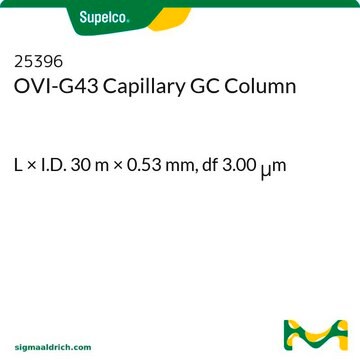24092
SPB®-35 Capillary GC Column
L × I.D. 30 m × 0.25 mm, df 0.25 μm
Sign Into View Organizational & Contract Pricing
All Photos(1)
About This Item
UNSPSC Code:
41115710
eCl@ss:
32119290
Recommended Products
material
fused silica
Agency
meets requirements for USP G42
parameter
0-300 °C temperature (isothermal or programmed)
Beta value
250
df
0.25 μm
technique(s)
gas chromatography (GC): suitable
L × I.D.
30 m × 0.25 mm
matrix active group
Bonded; poly(35% diphenyl/65% dimethyl siloxane) phase
application(s)
clinical
environmental
food and beverages
forensics and toxicology
column type
capillary intermediate polar
Looking for similar products? Visit Product Comparison Guide
Related Categories
General description
Application: With a phenyl content of 35%, this column offers a higher polarity option compared to columns containing a lower phenyl content. This column is useful for analyses of polar compounds because they are retained longer relative to non-polar compounds.
USP Code: This column meets USP G42 requirements.
Phase:
USP Code: This column meets USP G42 requirements.
Phase:
- Bonded
- Poly(35% diphenyl/65% dimethyl siloxane)
- 0 °C to 300 °C (isothermal or programmed)
Application
SPB®-35 fused silica capillary column may be used to determine pesticide retention times, in gas chromatography equipped with electron capture detector used for determining common pesticides like parathion-methyl, fenitrothion, chlorpyrifos, dichlofluanid, vinclozolin, chlozolinate, procymidone and iprodione in musts and wine.
Other Notes
We offer a variety of chromatography accessories including analytical syringes
Legal Information
SPB is a registered trademark of Merck KGaA, Darmstadt, Germany
Choose from one of the most recent versions:
Already Own This Product?
Find documentation for the products that you have recently purchased in the Document Library.
Quick gas chromatographic method for determining common pesticides in musts and wines.
Sala C
Chromatographia, 44 (5-6), 320-324 (1997)
M Buratti et al.
Journal of chromatography. B, Biomedical sciences and applications, 723(1-2), 95-104 (1999-03-18)
Methylhippuric acid isomers (MHAs), urinary metabolites of xylenes, were determined, after clean-up by C18-SPE and esterification with hexafluoroisopropanol and diisopropylcarbodiimide, by GC with ECD detection, on an SPB-35 capillary column (30 m, 0.32 mm I.D., 0.25 microm film thickness, beta
Joseph Findley et al.
The West Virginia medical journal, 111(3), 22-28 (2015-06-09)
Currently ACOG recommends that a mid-term screening strategy may be considered to identify short cervix in low risk populations in an effort to prevent preterm birth. Vaginal progesterone is recommended for women with a cervical length ≤20 mm. Cerclage is
Luisa A Wetta et al.
American journal of perinatology, 31(6), 541-546 (2013-09-12)
The objective of this study is to evaluate whether midtrimester maternal vitamin D is associated with preeclampsia < 37 weeks or spontaneous preterm birth (SPTB) < 35 weeks. Nested case-control comprising two case subsets: (1) 100 women with preeclampsia < 37 weeks and (2) 100 women
Our team of scientists has experience in all areas of research including Life Science, Material Science, Chemical Synthesis, Chromatography, Analytical and many others.
Contact Technical Service



